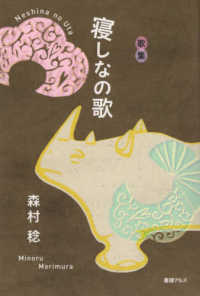- ホーム
- > 洋書
- > 英文書
- > Science / Mathematics
Full Description
This book highlights the multiple ways of telling stories of radiation exposure; they include stories about Japan, Australia, the United States, the Canadian Arctic, and more, and they probe the framing of major incidents such as Three Mile Island, Chernobyl, and Fukushima. All the chapters in this book are written by authors who participated in our work at Oregon State University and have benefited from hearing not only from scientists but also from those whose lives were directly affected by the history of radiation exposure. The question 'What is at stake when researching and narrating the histories of radiation exposure?' is discussed, but the book does not reinforce existing frameworks, such as legal decisions or government policies, but rather highlights what narrative framings accomplish and commit by scrutinizing them with rigorous research, varied approaches, and, above all, listening to those whose lives were most affected by exposure.
Previously published in Journal of the History of Biology Volume 54, issue 1, April 2021
Contents
Connecting to the Living History of Radiation Exposure.- The Cosmology of Evidence: Suffering, Science, and Biological Witness After Three Mile Island.- Disproportionate Impacts of Radiation Exposure on Women, Children, and Pregnancy: Taking Back our Narrative.- Locating the Boundaries of the Nuclear North: Arctic Biology, Contaminated Caribou, and the Problem of the Threshold.- The Visual Politics of Maralinga: Experiences, (Re)presentations, and Vulnerabilities.- Let Chromosomes Speak: The Cytogenetics Project at the Atomic Bomb Casualty Commission (ABCC).- Embracing Mystery: Radiation Risks and Popular Science Writing in the Early Cold War.- Erika Lorraine Milam, Creatures of Cain: The Hunt for Human Nature in Cold War America, (Princeton: Princeton University Press, 2019), 408 pp., 33 b/w illus., $29.95 Cloth, ISBN: 9780691181882.






